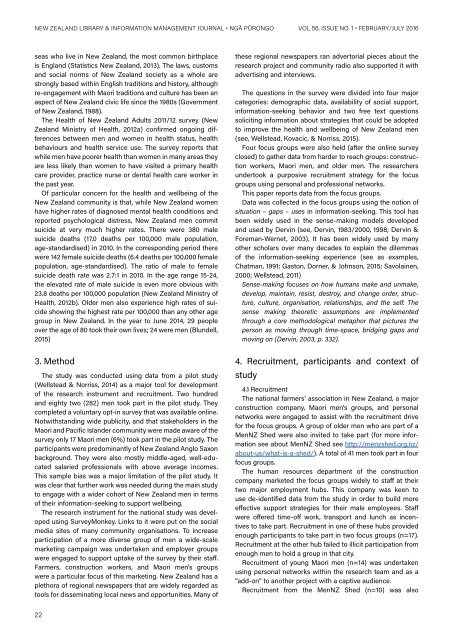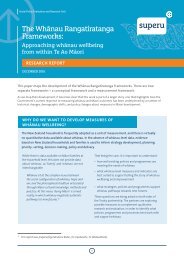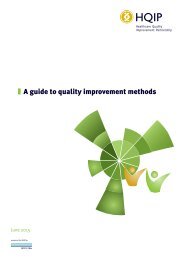THE NEW ZEALAND LIBRARY & INFORMATION MANAGEMENT JOURNAL NGĀ PŪRONGO
NZLIMJ%20FebJuly%202016
NZLIMJ%20FebJuly%202016
You also want an ePaper? Increase the reach of your titles
YUMPU automatically turns print PDFs into web optimized ePapers that Google loves.
<strong>NEW</strong> <strong>ZEALAND</strong> <strong>LIBRARY</strong> & <strong>INFORMATION</strong> <strong>MANAGEMENT</strong> <strong>JOURNAL</strong> • <strong>NGĀ</strong> <strong>PŪRONGO</strong> VOL 56, ISSUE NO. 1 • FEBRUARY/JULY 2016 <strong>NEW</strong> <strong>ZEALAND</strong> <strong>LIBRARY</strong> & <strong>INFORMATION</strong> <strong>MANAGEMENT</strong> <strong>JOURNAL</strong> • <strong>NGĀ</strong> <strong>PŪRONGO</strong> VOL 56, ISSUE NO. 1 • FEBRUARY/JULY 2016<br />
seas who live in New Zealand, the most common birthplace<br />
is England (Statistics New Zealand, 2013). The laws, customs<br />
and social norms of New Zealand society as a whole are<br />
strongly based within English traditions and history, although<br />
re-engagement with Maori traditions and culture has been an<br />
aspect of New Zealand civic life since the 1980s (Government<br />
of New Zealand, 1988).<br />
The Health of New Zealand Adults 2011/12 survey (New<br />
Zealand Ministry of Health, 2012a) confirmed ongoing differences<br />
between men and women in health status, health<br />
behaviours and health service use. The survey reports that<br />
while men have poorer health than women in many areas they<br />
are less likely than women to have visited a primary health<br />
care provider, practice nurse or dental health care worker in<br />
the past year.<br />
Of particular concern for the health and wellbeing of the<br />
New Zealand community is that, while New Zealand women<br />
have higher rates of diagnosed mental health conditions and<br />
reported psychological distress, New Zealand men commit<br />
suicide at very much higher rates. There were 380 male<br />
suicide deaths (17.0 deaths per 100,000 male population,<br />
age-standardised) in 2010. In the corresponding period there<br />
were 142 female suicide deaths (6.4 deaths per 100,000 female<br />
population, age-standardised). The ratio of male to female<br />
suicide death rate was 2.7:1 in 2010. In the age range 15-24,<br />
the elevated rate of male suicide is even more obvious with<br />
23.8 deaths per 100,000 population (New Zealand Ministry of<br />
Health, 2012b). Older men also experience high rates of suicide<br />
showing the highest rate per 100,000 than any other age<br />
group in New Zealand. In the year to June 2014, 29 people<br />
over the age of 80 took their own lives; 24 were men (Blundell,<br />
2015)<br />
3. Method<br />
The study was conducted using data from a pilot study<br />
(Wellstead & Norriss, 2014) as a major tool for development<br />
of the research instrument and recruitment. Two hundred<br />
and eighty two (282) men took part in the pilot study. They<br />
completed a voluntary opt-in survey that was available online.<br />
Notwithstanding wide publicity, and that stakeholders in the<br />
Maori and Pacific Islander community were made aware of the<br />
survey only 17 Maori men (6%) took part in the pilot study. The<br />
participants were predominantly of New Zealand Anglo Saxon<br />
background. They were also mostly middle-aged, well-educated<br />
salaried professionals with above average incomes.<br />
This sample bias was a major limitation of the pilot study. It<br />
was clear that further work was needed during the main study<br />
to engage with a wider cohort of New Zealand men in terms<br />
of their information-seeking to support wellbeing.<br />
The research instrument for the national study was developed<br />
using SurveyMonkey. Links to it were put on the social<br />
media sites of many community organisations. To increase<br />
participation of a more diverse group of men a wide-scale<br />
marketing campaign was undertaken and employer groups<br />
were engaged to support uptake of the survey by their staff.<br />
Farmers, construction workers, and Maori men’s groups<br />
were a particular focus of this marketing. New Zealand has a<br />
plethora of regional newspapers that are widely regarded as<br />
tools for disseminating local news and opportunities. Many of<br />
these regional newspapers ran advertorial pieces about the<br />
research project and community radio also supported it with<br />
advertising and interviews.<br />
The questions in the survey were divided into four major<br />
categories: demographic data, availability of social support,<br />
information-seeking behavior and two free text questions<br />
soliciting information about strategies that could be adopted<br />
to improve the health and wellbeing of New Zealand men<br />
(see, Wellstead, Kovacic, & Norriss, 2015).<br />
Four focus groups were also held (after the online survey<br />
closed) to gather data from harder to reach groups: construction<br />
workers, Maori men, and older men. The researchers<br />
undertook a purposive recruitment strategy for the focus<br />
groups using personal and professional networks.<br />
This paper reports data from the focus groups.<br />
Data was collected in the focus groups using the notion of<br />
situation – gaps – uses in information-seeking. This tool has<br />
been widely used in the sense-making models developed<br />
and used by Dervin (see, Dervin, 1983/2000, 1998; Dervin &<br />
Foreman-Wernet, 2003). It has been widely used by many<br />
other scholars over many decades to explain the dilemmas<br />
of the information-seeking experience (see as examples,<br />
Chatman, 1991; Gaston, Dorner, & Johnson, 2015; Savolainen,<br />
2000; Wellstead, 2011)<br />
Sense-making focuses on how humans make and unmake,<br />
develop, maintain, resist, destroy, and change order, structure,<br />
culture, organisation, relationships, and the self. The<br />
sense making theoretic assumptions are implemented<br />
through a core methodological metaphor that pictures the<br />
person as moving through time-space, bridging gaps and<br />
moving on (Dervin, 2003, p. 332).<br />
4. Recruitment, participants and context of<br />
study<br />
4.1 Recruitment<br />
The national farmers’ association in New Zealand, a major<br />
construction company, Maori men’s groups, and personal<br />
networks were engaged to assist with the recruitment drive<br />
for the focus groups. A group of older men who are part of a<br />
MenNZ Shed were also invited to take part (for more information<br />
see about MenNZ Shed see http://menzshed.org.nz/<br />
about-us/what-is-a-shed/). A total of 41 men took part in four<br />
focus groups.<br />
The human resources department of the construction<br />
company marketed the focus groups widely to staff at their<br />
two major employment hubs. This company was keen to<br />
use de-identified data from the study in order to build more<br />
effective support strategies for their male employees. Staff<br />
were offered time-off work, transport and lunch as incentives<br />
to take part. Recruitment in one of these hubs provided<br />
enough participants to take part in two focus groups (n=17).<br />
Recruitment at the other hub failed to illicit participation from<br />
enough men to hold a group in that city.<br />
Recruitment of young Maori men (n=14) was undertaken<br />
using personal networks within the research team and as a<br />
“add-on” to another project with a captive audience.<br />
Recruitment from the MenNZ Shed (n=10) was also<br />
undertaken using personal networks and a somewhat<br />
captive audience. Many men who attend “shed” activities<br />
are empowered to improve the health and<br />
wellbeing of men (often as a result of periods<br />
of poor health and wellbeing themselves) and<br />
those that took part in the focus group were<br />
keen to support this endeavour.<br />
4.2 Participants<br />
The participants in the focus groups ranged<br />
in age from 18 to 89 (the 89 year old was turning<br />
90 the week after the focus group). Most participants<br />
were in a relationship and had children.<br />
Most stated their highest level of education<br />
as secondary or trade. Only four men in the<br />
groups had a degree level qualification and one<br />
had an honours degree. These demographic<br />
details reflect the make-up of New Zealand<br />
society overall. New Zealand is a socially conservative<br />
country where farming, forestry and<br />
construction are major industries. These industries<br />
are major employers of men throughout<br />
the country. Degree qualification was relatively<br />
rare until recent time. A large proportion of<br />
the participants were construction workers for<br />
whom a trade qualification is the normal route<br />
to employment, even for those who move into<br />
management positions. Maori men face considerable<br />
educational disadvantage and their educational<br />
status reported here reflects this.<br />
Being a socially conservative country a large<br />
proportion of the community live in relationships<br />
with children. The participants in the focus<br />
group conform to this norm. Twenty nine (29)<br />
of the forty one participants (41) indicated that<br />
they were in a relationship and thirty four of the<br />
these men had children. A number of the Maori<br />
men indicated that they had children but were<br />
not in a relationship. This is a common pattern<br />
of life for young Maori men. Teenage pregnancy<br />
is high in the Maori community and the children<br />
from these pregnancies are often raised by<br />
their mother and her extended family (whanua)<br />
rather than within a marriage type relationship.<br />
Table 1.<br />
Shed<br />
Demographic Data for Men from MenNZ<br />
Table 2.<br />
Table 3.<br />
Demographic Data for Construction Workers<br />
Demographic Data for Maori Men<br />
4.3 Conducting the groups<br />
Two of the focus groups (Maori men and<br />
older men) were held in regional centres. The<br />
construction workers’ focus groups took place<br />
in a major city. The groups for construction<br />
workers and older men were facilitated by the<br />
lead researcher (female) and a male member<br />
of the steering group for the research project<br />
(“Tom”). A Maori member of the research team<br />
(male) and “Tom” conducted the focus group<br />
with the Maori men.<br />
At the beginning of each group the participants<br />
were given a “sign-in” sheet where they<br />
22 23






